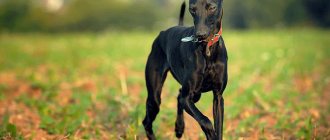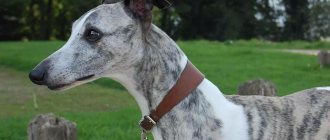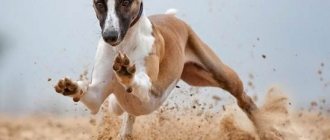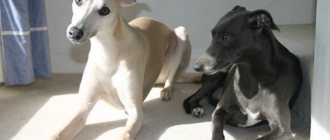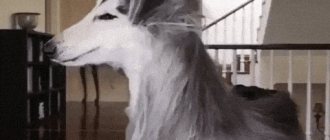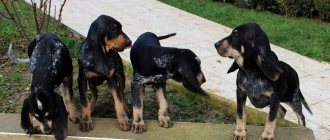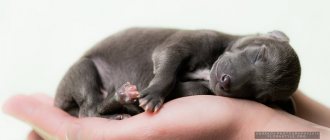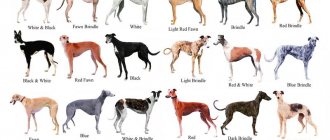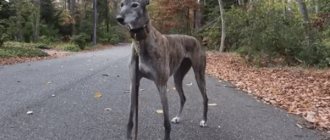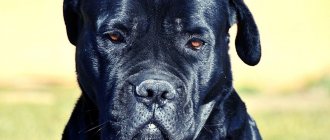The Italian Greyhound is a completely domestic animal; its habits closely resemble those of cats. Dogs do not like to walk during bad weather, but will be very happy to lie under the warm rays of the sun. The dog is extremely devoted to its owner , always accompanies him and shows his love in every possible way.
If you are a lover of greyhounds , but are hesitant to have such a large pet in a small apartment, pay attention to the decorative Italian Greyhound breed. These dogs are also called small Italian greyhounds, or Italian greyhounds . As if created in the image of ancient figurines, representatives of this breed are distinguished by elegance and graceful movements.
Breed characteristics
| Short description | |
| Origin: | Italy |
| Conditions of detention: | In a house or apartment without a garden |
| Purpose: | Companion |
| Color: | Black, gray or isabella |
| Wool length: | Short 2-4 cm |
| Adult dog size: | Dogs are 33-38 cm tall, weigh approximately 2.7-4.5 kg |
| Average life expectancy: | 12-16 years old |
| Walk: | Needed 2-3 times a day |
| Physical activity needs: | Average physical activity needs. Walks for 2 hours 2-3 times a day |
| Fédération Cynologique Internationale (FIC) classification: | Group No. 10 greyhounds; Section No. 3 short-haired greyhounds |
| Puppy price: | From 25 to 45 thousand rubles. Puppies bought as companions will cost 25-30 thousand rubles, and show-class dogs - 30-45 thousand rubles. |
Health
The average life expectancy of a small Italian greyhound is 12-15 years. With proper care, such a pet can live up to the age of sixteen.
In order to keep the dog’s body healthy and to prevent many diseases, the owner must carry out treatment against external and internal parasites, do timely vaccinations, and for the sake of prevention, periodically show the pet to a veterinarian.
The Italian Greyhound naturally enjoys good health, but a predisposition to certain diseases and health problems are still observed:
- Limb fractures - most often occur due to excessive activity of the animal. Young Italian Greyhounds tend to overestimate their strength and, as a result, get injured.
- Dental diseases – many individuals experience early tooth loss.
- Eye diseases – retinal atrophy, cataracts.
- Articular Partes disease is aseptic necrosis of the femoral head.
- Epilepsy - seizures of unknown etiology occur.
- Baldness comes in varying degrees of intensity.
- Cryptorchidism – leads to a decrease or complete extinction of spermatogenesis.
- Color mutation alopecia is a hereditary disease.
- Dysplasia – joints suffer, the disease causes severe pain to the dog and leads to lameness.
History of the origin of the species
Today, scientists cannot say for sure which country is the ancestral home of dogs . However, the first mentions of the breed date back to the periods of ancient Egypt, the Roman and Ottoman Empires.
The name of the breed comes from the French word " evrette d'Italie ", which literally translates as hare. Italian Greyhound owes its second name “Italian greyhound” to Italian aristocratic families and its spectacular appearance. The Italian aristocracy in the 17th century made good advertising for these dogs, after which they appeared in Great Britain, and then in all the courts of Western Europe.
Although these dogs were initially used exclusively for hunting, they soon began to be kept as companion dogs for their appearance.
During the Second World War, dogs of this breed were bred as helpers. They were looking for the wounded. Because of this, already at the end of the war the number of Italian greyhounds numbered in the hundreds. To restore the population, it was decided to bring Italian Greyhounds from the USA, where they were already very popular among wealthy Americans at that time.
At some point, breeders decided to make miniature animals from this breed that could become an excellent accessory. However, due to selection experiments, a large number of puppies with disproportionate limbs and noticeable developmental delays have appeared in the world. Because of this, in the 20th century a special club was created, the main goal of which was aimed at restoring the original parameters of the breed.
Possible diseases
The same rule applies to Italian greyhounds as to other decorative dogs - the smaller the dog, the longer its life expectancy. Representatives of the Italian Greyhound breed live up to 15-16 years.
And if you take good care of it and take it for “technical inspections” to the veterinarian at least once every six months, then there is a chance that the dog will not catch any disease in its entire life. However, owners should still keep their eyes open and know the typical ailments characteristic of this breed.
The sooner the owner is alerted to signs of some disease, the sooner he will take the dog for diagnosis, and the more effective the treatment will be. The most common diseases are ophthalmological. We are talking about glaucoma, retinal atrophy, corneal dystrophy and cataracts. If you do not keep track of it in time, the disease will lead to complete loss of vision.
In addition, Italian Greyhounds tend to go bald due to dermatitis. Scientifically the disease is called alopecia. You should be more careful about your pet's skin care products and use special shampoos. It is better if they are dry - these products are more gentle.
Among the neurological disorders, Italian Greyhounds can be plagued by epileptic seizures, and problems with the jaw and teeth are expressed in the form of tartar, plaque, and even loss of incisors.
Distinctive features
The main features of Italian Greyhounds are:
- The head is long in shape, with pronounced eyebrow arches and flattened cheekbones.
- The nose is distinguished by a dark lobe with large nostrils.
- The muzzle is elongated with a sharp end, dark and tightly set lips.
- The jaw is powerful, with incisors set in a semicircle, not protruding beyond the line.
- The teeth are large, set perpendicular to the jaw, with a scissor bite.
- The eyes are expressive, round in shape, dark in color and not protruding.
- The ears are small in size, set high, raised at the base, and pulled back at the end.
- The tail is covered with hair, thinned towards the base and set low.
- The body is muscular, the back is straight, the sternum is narrow and deep, and the ribs are curved.
- The coat is short, silky and fine, black or gray in color.
- The paws are powerful, long and thin, semicircular with tightly knit toes.
Limbs
The long shoulders are only slightly sloping and well developed, they are also muscular, although they appear lean. The legs of Italian Greyhounds are completely straight, vertical, parallel to each other and have lean muscles with a clearly visible skin imprint. The hind legs are well angled for this. The angle in the shoulder joint of the front legs is very obtuse. A clear groove is visible from the elbow to the wrist.
The thighs are dry, long, muscular, but not very wide, and the shins are steep. The popliteal bone is parallel in posterior view. The hind legs are less oval than the front legs. The toes are small, compact and well arched. The finger pads are small and darkly pigmented, with black or dark nails (depending on color).
Italian Greyhounds move very elegantly and gracefully. Their trot is harmonious, elastic and slightly high. The front legs of these dogs are thrown far forward. At the same time, adult Italian greyhounds reach speeds of up to 40 km/h.
Photo of an adult dog
Photos of puppies
Features of character and behavior
These are attached and very devoted pets to their owner . It is not surprising that they always try to be near their owner and have a hard time with parting. In addition, they are quite affectionate and gentle dogs that do not tolerate rudeness and indifference from their owners.
One of the main character traits of this breed is excessive obedience, but in order to achieve it, you need to raise the dog correctly . Therefore, dog training must begin as early as possible. Italian Greyhounds are quite intelligent. Therefore, they often try to manipulate people. To prevent this from happening, the owner needs to become an authority for his pet.
Another very important character trait of Italian Greyhounds is considered to be excessive timidity, which can create difficulties with their maintenance. Families where scandals and showdowns often occur are better off not getting these dogs. Because they will experience constant tension and stress.
These dogs do not tolerate large breeds, so conflict situations often arise between them. In addition, it is not recommended to have them if cats, small rodents or small children already live in the house. At the same time, they get along well with representatives of their own species. Therefore, you can keep several Italian greyhounds in the house at once.
Advantages
The main advantages of the breed include:
- tenderness and complaisance;
- exceptional devotion and loyalty;
- good learning ability;
- playfulness and high intelligence.
Flaws
There are several disadvantages of Italian Greyhounds:
- excessive fearfulness;
- not friendly towards other breeds;
- excessive requirements for content.
Interesting Facts
According to one version, the dwarf greyhound first appeared in Ancient Egypt. The basis for this theory is the skeletons of animals found during archaeological excavations, which are as similar as possible to representatives of this breed. The remains found are more than five thousand years old. According to these data, Italian greyhounds can be classified as the most ancient groups of dogs .
In the Middle Ages, the breed was popular among noble families. The Prussian king was also an admirer of Italian greyhounds; at least 50 representatives of the breed lived on his estate. It was this man who owned the phrase that is now popular: “The more I get to know people, the more I like dogs .
Care and maintenance
Italian Greyhound can be kept in a house or apartment. It is worth noting that dogs of this breed often freeze and are afraid of drafts. Therefore, in case of cold weather outside, they will have to buy clothes, or rather special sets - winter, demi-season and moisture-proof. To prevent your dog from getting frostbitten paws in winter, it is recommended to buy dog shoes.
Increasingly, there is information that the delicate skin of dogs is adversely affected by the reagents used to cover roads in winter and spring. Therefore, the dog definitely needs shoes. However, this fact is not scientifically supported and most breeders believe that information about the mandatory wearing of shoes by dogs is disseminated by dog clothing manufacturers.
- Italian Greyhounds require special care for their eyes . Because the breed is prone to ophthalmological diseases. Therefore, the dog's eyes require daily examination.
- The slightest redness and cloudiness of the mucous membrane should be a reason to immediately contact a veterinarian.
- Italian Greyhounds also require ear cleaning , which should take place at least once every two weeks. You should be alert to a colored coating with an unpleasant odor, redness, baldness on the back of the ears or frequent shaking of the head, which indicates pain in the ears.
- If a dog actively and often goes for walks, then its nails will wear down naturally; if not, then they need to be trimmed. They also need to be checked for chips, cracks and delamination. Since the presence of these signs may indicate a serious illness in the dog.
- Due to the high risk of dental , it is recommended to have them cleaned regularly. To do this, you need to buy special products and a brush at the veterinary store.
Nutrition
Italian Greyhound can eat dog food . However, it should not cause allergic reactions on the dog's skin. To do this, it is worth carefully studying the composition of the selected feed. It must be natural, designed specifically for small and short-haired dogs, and the pet must eat it with great appetite.
Prohibited foods for these dogs include:
- garlic and onion;
- confectionery and flour products;
- large tubular bones;
- dried grapes;
- mushrooms and nuts;
- broccoli and potatoes;
- raw eggs.
It is noteworthy that adult Italian Greyhounds have excellent digestion. Therefore, some representatives of the breed eat only once a day. In this case, puppies need to be fed at least three times a day.
Italian Greyhounds can be fed buckwheat and brown rice . They also love steamed vegetables and boiled meat. It could be chicken, beef or veal. Pets of this breed often require protein, the source of which can be boiled chicken or quail eggs.
Health
Italian Greyhounds live no more than 15 years. These are quite sickly dogs. This is mainly due to the lack of subcutaneous fat and short hair. That is why it is recommended to dress them warmly during cold periods.
Vaccinations
The breed is vaccinated against the following diseases:
- plague;
- parvovirus and parainfluenza;
- viral hepatitis;
- rabies;
- leptospirosis;
- coronavirus;
- trichophytosis.
The first vaccination is given at 2 months . After this, the dog is prohibited from bathing, overfeeding and walking for two weeks. At this time, the Italian greyhound develops immunity. This period is considered the most dangerous for the pet's health. Since most dogs develop a high fever, general weakness and diarrhea appear.
The second vaccination is carried out three weeks after the first. As a rule, it already passes without complications. However, even at this time, the dog should be isolated from other pets, fenced off from drafts and stopped walking. Isolation must continue for two weeks .
When the dog is six months old, it is vaccinated against rabies and several other diseases. After another six months, comprehensive vaccination is carried out. After this, vaccination is carried out once a year.
Diseases
This dog has many hereditary diseases:
- cataract;
- periodontal disease;
- glaucoma;
- alopecia;
- cryptorchidism in males;
- epilepsy;
- mammary cancer;
- thyroid dysfunction;
- dermatitis;
- navel hernia;
- ectromelia;
- baldness;
- congenital deafness.
Walk
This breed of dog requires long and active walks in the fresh air, which is due to their highly active and playful disposition. The minimum time for one walk is 2 hours. Moreover, there should be at least two such walks a day. Therefore, if you don’t have such time, then it’s better to forget about buying an Italian greyhound puppy.
It will not be superfluous to visit sports grounds with your dog that are specially equipped for training. Given the pet's high intelligence and good memory, it can be taught any dog tricks.
Swimming is a great way to keep your dog in good physical shape. To do this, you can use any body of water located near your home.
Grooming
- Caring for the coat involves combing with a rubber brush.
- Although the dog of this breed is considered short-haired, their shedding is very noticeable, especially for females.
- Brushing the coat daily with a rubber brush will minimize coat changes.
- It is recommended to bathe an Italian greyhound only during the season or when absolutely necessary. This is due to the fact that these dogs have very sensitive skin. Therefore, even small contact with water seriously damages the outer layer of the skin.
- As detergents, you can only use specialized shampoos designed for short-haired dogs with sensitive skin.
Hygiene
Typically, caring for Italian Greyhounds is limited to weekly combing of the coat and bathing once every 10-12 days using pet shampoo for short-haired breeds. By the way, even Italian greyhounds who neglect regular baths do not smell like dogs at all. There are also few worries with the dog's eyes. Standard prevention of souring of the mucous membrane is sufficient, that is, wiping the eyes with a cloth soaked in cooled tea or chamomile infusion. However, if the inside of the eyelid has acquired a reddish tint, and the eye looks swollen, herbal decoctions are not helpful. Moreover, experimenting with natural remedies can end badly for your eyesight if a visit to the veterinarian is postponed for some reason.
Like many lap dogs, Italian greyhounds' claws do not grind down, so once a month the pet will have to have a “pedicure” session - a nail clipper for small breeds and a file for polishing to help. It is better to clean your mouth once a week so as not to accumulate plaque on your teeth. Don’t expect any particular joy from the animal during the process, but individuals who are accustomed to the procedure from early childhood are usually able to complete what they started. The main thing is to find a suitable attachment for the miniature Italian Greyhound’s mouth. If one is not found, a regular children's toothbrush will do. Examining the ears of an Italian Greyhound is not the most pleasant job, but it is necessary. Once every seven days, unroll the ear flap and look into the ear canal. If dirt and wax are visible inside, remove it with a damp cotton ball or use veterinary lotion.
Mating
Sexual maturation of Italian greyhounds begins at 8-10 months of life. However, it is better to carry out mating when the female is not 1.5 years old , that is, at 2-3 estrus . Mating is carried out 11-15 days after its start.
Before mating, the Italian Greyhound needs to be given a good walk, but not fed. It is better to introduce dogs in a neutral place and then lead them to the male’s territory. After this, it is better to leave the pets alone so as not to spoil the process or frighten them away.
Feeding an Italian Greyhound
The diet of a miniature greyhound should consist of:
- large pieces of beef with films and cartilage - this is healthier for digestion, as well as bones and joints;
- fillet of lean sea fish (for example, the cod family), it is better to scald it first;
- low-fat homemade cottage cheese;
- cereals, for example, rolled oats, unpolished rice;
- vegetable salads seasoned with vegetable oil;
- greens (parsley and dill);
- vitamin and mineral complexes (with the fragility of the Italian greyhound, calcium is especially important);
- clean water.
It is forbidden to give dogs fried, fatty, sweet, flour, salty, smoked and spicy food. Many foods can cause allergies in Italian greyhounds: horse meat, buckwheat, egg white, etc.
If there are difficulties in preparing a balanced diet, the best option would be premium and super-premium industrial food for small breeds, for example:
- Grandorf Adult All Breeds 4 Meat & Brown Rice Hypoallergenic;
- Piccolo Small Dogs Salmon & Venison;
- Applaws Adult Dog Small & Medium Breed Chicken Grain Free Hypoallergenic;
- Brit Care Adult Dog Small Breed Lamb & Rice Hypoallergenic;
- Eukanuba Adult Small Breed.
Photo gallery: industrial food for Italian greyhounds
Hypoallergenic food Grandorf Adult All Breeds 4 Meat & Brown Rice contains turkey, duck, rabbit and lamb meat
Piccolo Small Dogs grain-free salmon and venison food is suitable for miniature dogs
Hypoallergenic food Applaws Adult Dog Small & Medium Breed Chicken Grain Free consists of chicken meat and vegetables
Brit Care Adult Dog Small Breed Lamb & Rice Hypoallergenic food contains lamb meat, as well as crustacean shells and cartilage extract, ensuring the health of the musculoskeletal system of small breed dogs
Eukanuba Adult Small Breed food contains poultry meat and a complex of polyunsaturated fatty acids
Key points in training
Thanks to their good intelligence, quick reaction and attention to detail, they are easy to train. The only problem that may arise during the training process is the dog’s high excitability and vulnerable nature. Therefore, during training, you should not allow yourself to be rude to your pet.
You can start training immediately after purchasing a puppy . Street training is best done after 3-4 months of life. For training to be successful, it is necessary to break the dog’s stubborn temperament. To do this, it is enough to become a leader for the Italian greyhound.
Read about how to properly train a dog in the article: “Training a puppy: effective methods from dog handlers, learning commands at home.”
Training is best done after an active walk, when the pet has released excess energy. To reward a dog for good academic performance, you can give it sweets, and as a punishment, raise your voice or ignore the dog.
Purpose
The Italian Italian Greyhound is a decorative breed of dog that must be kept exclusively at home. But this was not always the case; before, these dogs were used to hunt small game and rodents. In some provinces of Italy, Italian Greyhounds are still trained and used to herd rabbits. Thanks to participation in greyhound racing, the breed has become popular throughout the world . Despite its fragile appearance, the Italian greyhound is quite strong and resilient, and enjoys sports games.
How to choose a puppy
It is worth noting that buying a puppy is a very expensive and troublesome task that requires a thorough and serious approach to the matter. To make the right choice you will have to visit more than one nursery.
- First, you should visit an exhibition where you can get acquainted with the best examples of the breed, breeders and pedigrees.
- When choosing a puppy, it is important to make sure that he is completely healthy, and that his coat and ears are clean.
- You should also find out whether the dog has already been vaccinated or not.
- You need to take a closer look at the puppy's gait. It should resemble the movements of a trot. If this is so, then the puppy is healthy and does not lag behind in physical development.
In conclusion, it is worth saying that Italian Greyhounds are dogs with a sensitive and kind nature that need constant love and affection. This dog is not worth buying if it cannot be provided with the necessary care and a quiet family life. With proper care and attention, the Italian Greyhound will become a loyal and devoted friend.
3 / 5 ( 2 voices)
Walk
Although the Italian greyhound is small, it is still a greyhound, so in order to feel normal, it needs to “have a blast” somewhere every day. If coursing and agility don’t work out for you, compensate your animal for the lack of sports with intensive walking. Just remember to dress your pet in overalls and blankets in cold weather. An Italian greyhound shaking from an overabundance of emotions and cold is a sight both comical and pitiful at the same time. However, even if you manage to get your ward out of the entrance in damp, chilly weather, he will dive back into the apartment in a minute. Italian Greyhounds absolutely cannot stand bad weather, and even the most interesting walk will not make them refuse the opportunity to take a nap in the warmth and dryness.
It is important to understand that for the Italian greyhound, the street is like a fascinating series for a person: it draws you in so much that it is impossible to tear yourself away. Having breathed fresh air into his lungs, the four-legged merry fellow immediately switches his attention to external stimuli, and the owner’s requirements in the list of dog preferences are in penultimate place. Within the city, dog handlers do not recommend letting Italian Greyhounds off the leash at all. Firstly, driven by hunting instincts, they can disappear from view if they see a pigeon or mouse on the horizon. And secondly, Italian Greyhounds are very hungry for food, so they will pick up any strong-smelling piece from the ground, no matter how much you shout “Ugh!”
But it’s great to go on a picnic and fishing with Italian Greyhounds. Once in the wild, the dogs first go a little crazy with happiness, after which they begin to practice hunting. Don’t be surprised if one day a rather battered, long-eared creature is dragged to your fire. Some individuals have such strong hunting skills that they are able to catch small game without prior training.
All Italian greyhounds are desperate party girls, so if you come across a dog get-together while out for a walk, your ward will definitely express a desire to communicate with its participants. You shouldn’t frantically tug on the animal’s leash, trying to protect it from the wrath of man’s four-legged friends. Little greyhounds are aware of what a collective hierarchy is and never get into trouble.
